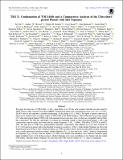Notice
This is not the latest version of this item. The latest version can be found at:https://dspace.mit.edu/handle/1721.1/135593.2
TKS X: Confirmation of TOI-1444b and a Comparative Analysis of the Ultra-short-period Planets with Hot Neptunes
| dc.date.accessioned | 2021-10-27T20:24:10Z | |
| dc.date.available | 2021-10-27T20:24:10Z | |
| dc.date.issued | 2021-08-01 | |
| dc.identifier.uri | https://hdl.handle.net/1721.1/135593 | |
| dc.description.abstract | We report the discovery of TOI-1444b, a 1.4-$R_\oplus$ super-Earth on a 0.47-day orbit around a Sun-like star discovered by {\it TESS}. Precise radial velocities from Keck/HIRES confirmed the planet and constrained the mass to be $3.87 \pm 0.71 M_\oplus$. The RV dataset also indicates a possible non-transiting, 16-day planet ($11.8\pm2.9M_\oplus$). We report a tentative detection of phase curve variation and secondary eclipse of TOI-1444b in the {\it TESS} bandpass. TOI-1444b joins the growing sample of 17 ultra-short-period planets with well-measured masses and sizes, most of which are compatible with an Earth-like composition. We take this opportunity to examine the expanding sample of ultra-short-period planets ($<2R_\oplus$) and contrast them with the newly discovered sub-day ultra-hot Neptunes ($>3R_\oplus$, $>2000F_\oplus$ TOI-849 b, LTT9779 b and K2-100). We find that 1) USPs have predominately Earth-like compositions with inferred iron core mass fractions of 0.32$\pm$0.04; and have masses below the threshold of runaway accretion ($\sim 10M_\oplus$), while ultra-hot Neptunes are above the threshold and have H/He or other volatile envelope. 2) USPs are almost always found in multi-planet system consistent with a secular interaction formation scenario; ultra-hot Neptunes ($P_{\rm orb} \lesssim$1 day) tend to be ``lonely' similar to longer-period hot Neptunes($P_{\rm orb}$1-10 days) and hot Jupiters. 3) USPs occur around solar-metallicity stars while hot Neptunes prefer higher metallicity hosts. 4) In all these respects, the ultra-hot Neptunes show more resemblance to hot Jupiters than the smaller USP planets, although ultra-hot Neptunes are rarer than both USP and hot Jupiters by 1-2 orders of magnitude. | |
| dc.language.iso | en | |
| dc.publisher | American Astronomical Society | |
| dc.relation.isversionof | 10.3847/1538-3881/ac02bd | |
| dc.rights | Article is made available in accordance with the publisher's policy and may be subject to US copyright law. Please refer to the publisher's site for terms of use. | |
| dc.source | The American Astronomical Society | |
| dc.title | TKS X: Confirmation of TOI-1444b and a Comparative Analysis of the Ultra-short-period Planets with Hot Neptunes | |
| dc.type | Article | |
| dc.relation.journal | The Astronomical Journal | |
| dc.eprint.version | Final published version | |
| dc.type.uri | http://purl.org/eprint/type/JournalArticle | |
| eprint.status | http://purl.org/eprint/status/PeerReviewed | |
| dc.date.updated | 2021-09-30T12:31:22Z | |
| dspace.orderedauthors | Dai, F; Howard, AW; Batalha, NM; Beard, C; Behmard, A; Blunt, S; Brinkman, CL; Chontos, A; Crossfield, IJM; Dalba, PA; Dressing, C; Fulton, B; Giacalone, S; Hill, ML; Huber, D; Isaacson, H; Kane, SR; Lubin, J; Mayo, A; Močnik, T; Akana Murphy, JM; Petigura, EA; Rice, M; Robertson, P; Rosenthal, L; Roy, A; Rubenzahl, RA; Weiss, LM; Zandt, JV; Beichman, C; Ciardi, D; Collins, KA; Gonzales, E; Howell, SB; Matson, RA; Matthews, EC; Schlieder, JE; Schwarz, RP; Ricker, GR; Vanderspek, R; Latham, DW; Seager, S; Winn, JN; Jenkins, JM; Caldwell, DA; Colon, KD; Dragomir, D; Lund, MB; McLean, B; Rudat, A; Shporer, A | |
| dspace.date.submission | 2021-09-30T12:31:23Z | |
| mit.journal.volume | 162 | |
| mit.journal.issue | 2 | |
| mit.license | PUBLISHER_POLICY | |
| mit.metadata.status | Authority Work and Publication Information Needed |
